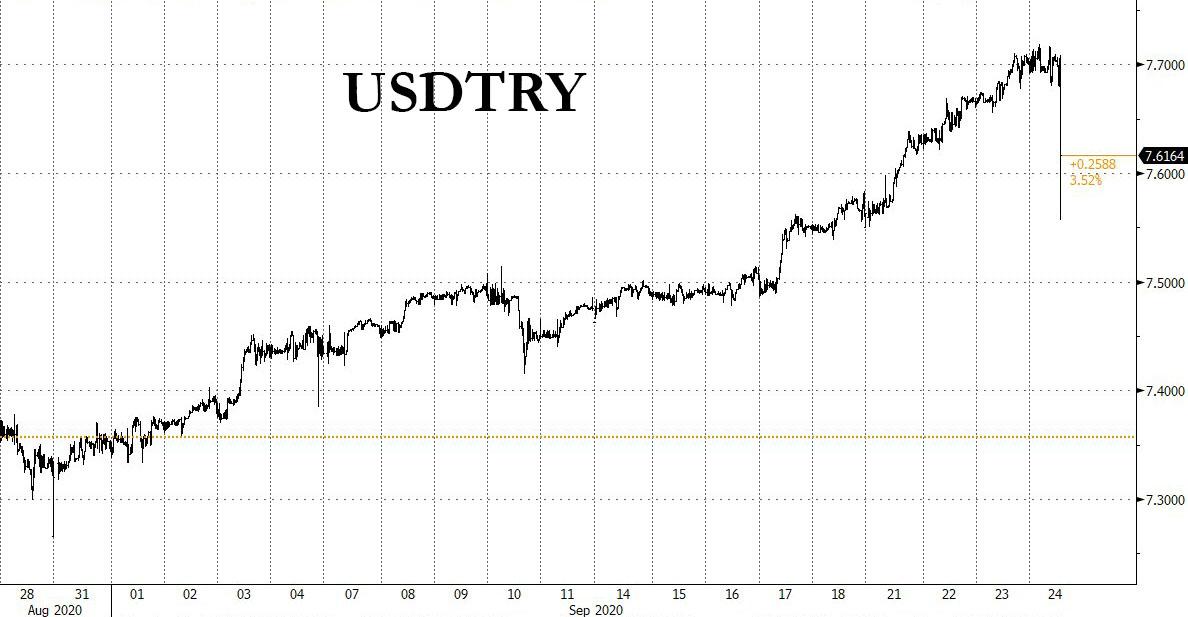Lira Drops Like A Stone After Turkish Central Bank Unexpectedly Hikes By 200 bps
Tyler Durden
Thu, 09/24/2020 – 07:30
With the Turkish economy hammered as a result of a collapse in global tourism, the country’s FX reserves dwindling by the day preventing the infamous Turkish interventions to stabilize the currency, Moody’s warning that Turkey faces an imminent balance of payments crisis, and the entire world cutting rates and easing to stimulate economies, the last thing Wall Street expected this morning from the CBRT was a rate hike – even though the Turkish Lira had been hitting daily record lows every single day for the past two weeks.
And yet moments ago, the Central Bank of Turkey shocked investors when it announced a whopping 200bps hike in the one week repo rate, from 8.25% to 10.25%, the first hike from Turkey in two years following an aggressive easing cycle which was unleashed when the rate hit a record 24% in late 2018.
Until now, political pressure from President Recep Tayyip Erdogan, who has demanded lower rates, forced the CBRT to tighten by stealth. Instead of hiking the main policy rate, the central bank had shut access to the one-week repo window, forcing banks to borrow at more expensive liquidity facilities. In the end, the central bank was forced to hike rates as the lira hit a record low against the dollar and inflation is still in double digits, while the average cost of CBRT funding has risen by almost 300 basis points since mid-July.
Wall Street economists had noted that the combination of an elevated risk premium, the challenging inflation outlook and subdued inflows suggested that the CBT was likely to implement further tightening, but consensus was that this would happen via liquidity measures.
Whether the hike was also driven by Turkey’s obsession with hammering TRY shorts remains unknown but the official explanation from the CBRT is that it decided to increase the policy rate by 200bps to restore the disinflation process and “support price stability” adding that “the Committee assessed that the tightening steps taken since August should be reinforced in order to contain inflation expectations and risks to the inflation outlook. Accordingly, the Committee decided to increase the policy rate by 200 basis points to restore the disinflation process and support price stability.”
The full statement is below:
While global economic activity has shown signs of partial recovery in the third quarter following the normalization steps taken by several countries, uncertainties on global economic recovery remain high. Advanced and emerging economies continue to maintain expansionary monetary and fiscal stances. The pandemic disease is closely monitored for its evolving global impact on capital flows, financial conditions, international trade and commodity prices.
Economic activity is recovering markedly in the third quarter owing to gradual steps towards normalization and the strong credit impulse. Recent monetary and fiscal measures that aim to contain negative effects of the pandemic on the Turkish economy contributed to financial stability and economic recovery by supporting the potential output of the economy. The normalization trend recently observed in commercial loans has started in consumer loans as well. The recent upturn in imports, which has resulted from deferred demand as well as pandemic-related liquidity and credit policies, is expected to moderate with the phasing out of these policy measures. Although tourism revenues declined due to the pandemic, easing of travel restrictions has started to contribute to a partial improvement. The recovery in exports of goods, relatively low levels of commodity prices and the level of the real exchange rate will support the current account balance in the upcoming periods.
Pandemic-related supply-side inflationary factors were expected to gradually phase out during the normalization process and demand-driven disinflationary effects were expected to become more prevalent. Yet, as a result of fast economic recovery with strong credit momentum, and financial market developments, inflation followed a higher-than-envisaged path. The Committee assessed that the tightening steps taken since August should be reinforced in order to contain inflation expectations and risks to the inflation outlook. Accordingly, the Committee decided to increase the policy rate by 200 basis points to restore the disinflation process and support price stability.
The Committee assesses that maintaining a sustained disinflation process is a key factor for achieving lower sovereign risk, lower long-term interest rates, and stronger economic recovery. Keeping the disinflation process in track with the targeted path requires the continuation of a cautious monetary stance. In this respect, monetary stance will be determined by considering the indicators of the underlying inflation trend to ensure the continuation of the disinflation process. The Central Bank will continue to use all available instruments in pursuit of the price stability and financial stability objectives.
In kneejerk response, the Turkish Lira jumped as much as 1.9% to 7.5572 per dollar before fading some of the gains to 7.6165.
It is too early to tell whether this surge can be sustained: in addition to economic considerations, traders are also focusing on the latest geopolitical developments: the EU leader summit scheduled for today was delayed to October 1-2 where Turkey’s tensions with Greece and Cyprus over Mediterranean Sea drilling will be discussed.
via ZeroHedge News https://ift.tt/3hZHggf Tyler Durden

